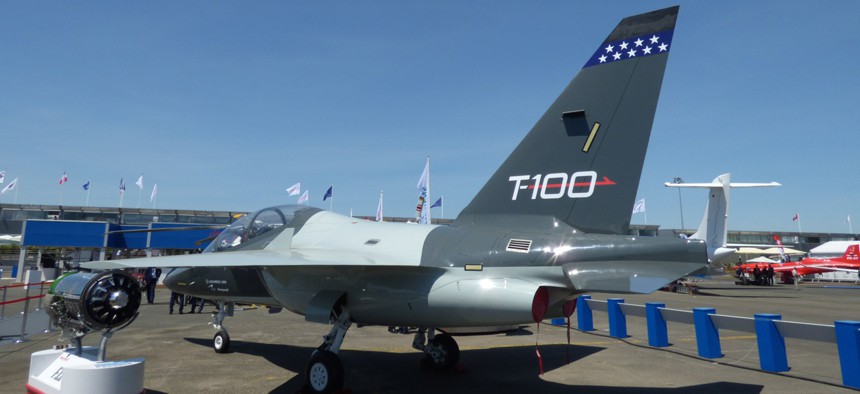
The Leonardo DRS T-100 pilot training jet at the 2017 Paris Air Show. Marcus Weisgerber/Defense One
One Man, One Job: Win The Pentagon’s Next Big Contract
Multibillion-dollar jet deal would be crowning achievement for former Deputy Defense Secretary Bill Lynn.
LE BOURGET, FRANCE — At the Paris Air Show this week, Bill Lynn, the very tall former deputy defense secretary from President Barack Obama’s first term, stood out among average-sized Italian and American businessmen.
The Italians hired Lynn in 2012 to land big U.S. government contracts. Capturing the prized, multibillion-dollar deal for 350 new Air Force pilot training planes would be Lynn’s crowning achievement. Towering above the rest, Lynn — now the CEO of the U.S. arm of Leonardo, the Italian aerospace firm formerly known as Finmeccanica — made his pitch to journalists on why he believes the U.S. Air Force should buy his company’s jet to train its next generation of pilots.
“This should be the low-cost proposal,” Lynn said of his company’s T-100, a plane that first flew more than a decade ago and is now being used by four countries’ air forces to train their pilots.
But in a contest with a diverse group of candidates, it’s anyone’s guess which plane the Air Force will select later this year.
Lynn, who ran Raytheon’s government operations and strategy division before becoming the No. 2-ranked civilian in the Pentagon, stresses that Leonardo’s plane, despite being Italian, will create American jobs and save U.S. taxpayers money. “This is going to be a U.S. system and fits extremely well into the priorities of the new administration,” Lynn said. In his short time in office, President Donald Trump has placed an emphasis on American jobs and pro-business policies. “We think this program fits right into the America First effort,” Lynn said.
The company has pledged to build a manufacturing plant in Tuskegee, Alabama, where it would fabricate parts and assemble them. The plane's engines would be built in Arizona and the training simulators in Florida.
Italy, Israel and Singapore already use one version of the T-100 to train their fighter pilots, a point the firm’s executives stress often. In the Air Force, the plane will largely train pilots before they get inside an F-35 Joint Strike Fighter. The Israeli Air Force is using the the plane to train its F-35 pilots. “It’s operationally proven,” Lynn said.
Leonardo DRS, the company’s U.S. arm, has already submitted its bid. In the coming weeks, the Air Force will flight test the T-100 to make sure it can meet basic performance requirements. This week, a T-100 jet was here in France on display at the air show for all passersby to see. Nine white stars, over a blue stripe, mimicking those on the American flag, are painted on the top of the jet’s tail.
But getting to this point has not been easy. Unlike its competitors who have the lobby of America’s two largest defense firms, Leonardo is in the pilot’s seat. It first partnered with U.S. firm General Dynamics to pitch the plane to the Air Force. But they ended their partnership before submitting a bid. Leonardo then partnered with Raytheon. They ended their partnership earlier this year. It's common for international firms to partner with American companies, to get legislative support, help open production facilities and be able to access classified information required to submit a bid.
The Italians bought DRS Technologies (now Leonardo DRS, run by Lynn) in 2008. And its executives are quick to point out that it’s still an American company.
The plane’s two main competitors also have a foreign flavor. The Lockheed Martin T-50 is jointly made by KAI, a South Korean firm. In addition to the South Korean air force, KAI also has built planes for Indonesia and the Philippines. If Lockheed wins, it plans to build the jets in South Carolina, at the same factory where it plans to move its F-16 fighter jet production line.
Then there’s Boeing, which has teamed with Sweden’s Saab to design and build a brand new jet. They have raced to build and certify two prototypes, drawing attention for the speed with which its program has progressed. If it wins, Boeing says it will build the planes in St. Louis.
Finally there’s a not-much-talked-about jet reportedly being built by Sierra Nevada and TAI, a Turkish firm. A blueprint-like silhouette of the plane that could be its proposal was on the front of Sierra Nevada’s chalet, or corporate booth, at the Paris show.
Aside from price, Lynn said the T-100 has other attributes that differentiate it from the competition, particularly its corporate partners. CAE, a training and simulation firm, is making realistic and networked T-100 simulators. He said this linking of simulators to the planes themselves separates his bid from the competition because “we’re the only ones who’ve already proven this in flight, in training, today.”
Additionally, legacy defense contractor Honeywell makes the plane’s engine. “All of this contributes to a low-risk program,” Lynn said.
